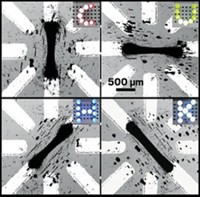Advertisement
Grab your lab coat. Let's get started
Welcome!
Welcome!
Create an account below to get 6 C&EN articles per month, receive newsletters and more - all free.
It seems this is your first time logging in online. Please enter the following information to continue.
As an ACS member you automatically get access to this site. All we need is few more details to create your reading experience.
Not you? Sign in with a different account.
Not you? Sign in with a different account.
ERROR 1
ERROR 1
ERROR 2
ERROR 2
ERROR 2
ERROR 2
ERROR 2
Password and Confirm password must match.
If you have an ACS member number, please enter it here so we can link this account to your membership. (optional)
ERROR 2
ACS values your privacy. By submitting your information, you are gaining access to C&EN and subscribing to our weekly newsletter. We use the information you provide to make your reading experience better, and we will never sell your data to third party members.
Materials
Nanoparticles Find And Repair Cracks In Electronics
Nanomaterials: Self-propelling particles that patch circuit wiring offer a simple way to fix broken electronics
by Prachi Patel
October 5, 2015


Microscopic cracks in wires printed on circuit boards can shorten the life of the electronic gadgets that have become indispensable nowadays. But those invisible cracks are hard to find and fix. A simple new repair system based on self-propelling nanoparticles offers hope for circuit healing (Nano Lett. 2015, DOI: 10.1021/acs.nanolett.5b03140). The engineered nanoparticles—made of gold and platinum and suspended in a hydrogen peroxide solution—autonomously detect surface cracks in circuit wiring and then nestle into the cracks to patch them.
To fix a broken circuit, the nanoparticle-containing solution could be placed on the surface of the circuit without needing to pinpoint the location of the damage, says Anna C. Balazs, a chemical engineer at the University of Pittsburgh. The solution simply dries up after about 30 minutes. “Our approach provides a simple way of repeatedly mending nano- to microscale cracks in electronic devices and on a range of scratched surfaces,” Balazs says.
Researchers have made various self-healing electronics in recent years. In these systems, it’s crucial for the repair to happen only at the damage site so as not to affect other parts of the circuit. One approach is to embed the circuit with tiny capsules or channels containing healing agents so that damage to the circuit breaks open these vessels, pouring out the healing agent. But this approach offers only a one-time repair for a given area.
Balazs, nanoengineer Joseph Wang of the University of California, San Diego, and their colleagues wanted to take a less invasive, repeatable approach. So they harnessed Janus nanoparticles, special types of particles with two different surfaces. They took 0.8- to 1.6-µm-wide gold spheres and coated one half of each sphere with a platinum film. They coated the other half with a single layer of hydrophobic octadecanethiol molecules.
When the particles are mixed into a dilute hydrogen peroxide solution, the platinum catalyzes the breakdown of peroxide into water and oxygen. The resulting increase in water concentration behind the nanoparticle creates a concentration gradient around the particle that propels it forward. As the reaction continues, the particles move continuously in a random pattern.
The hydrophobic half of the particle does the rest of the work. When the moving particles encounter a hydrophobic surface, such as the exposed silicon substrate underneath cracks in the wiring on a circuit board, the octadecanethiol coating sticks. The gold nanoparticle bridges the gap where the particle is stuck, and current can flow through the wires again.
To demonstrate the nanoparticles’ ability to seek and heal cracks, the researchers made gold electrodes on a silicon substrate that were connected to a light-emitting diode (LED). They scratched an electrode with a diamond tip to make 0.5- to 2.2-µm-wide cracks, which broke the circuit and exposed the hydrophobic substrate beneath, turning the LED off. Then they put droplets of the Janus particle suspension on the crack. Within five minutes, most of the particles got trapped in the cracks, restoring the conductive pathways across the gaps and re-lighting the LED.
“This work shows an exciting new application of self-propelled nano motors,” says Sámuel Sánchez, a researcher at the Max Planck Institute for Intelligent Systems, in Stuttgart, Germany.
Self-propelling Janus particles have been tested for drug delivery and environmental remediation before, says Wei Gao, a postdoctoral researcher at the University of California, Berkeley, but this is the first time they have been used for fixing broken circuits. These nanomotors’ ability to autonomously seek and fill in cracks makes them efficient for electronics repair, he says.





Join the conversation
Contact the reporter
Submit a Letter to the Editor for publication
Engage with us on Twitter